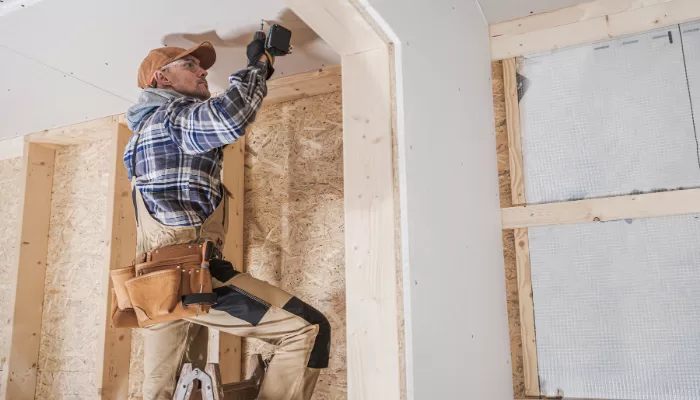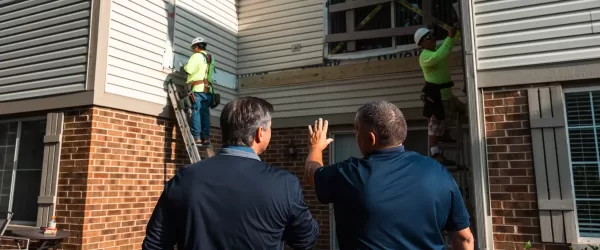What to Look for in a Chicago Commercial Construction Partner
Estimated Read Time: 7 Minutes
The Highlights
- What “Chicago commercial construction” really means today
- The 5 trends driving smarter project planning in 2025
- What separates reliable contractors from risky ones
- Tips for staying ahead of delays, complaints, and scope creep
- Where to learn more about getting started
Chicago Is Building—Fast. Are You Choosing the Right Partner?
Commercial construction in Chicago isn’t just about concrete, cranes, or blueprints. It’s about juggling tenant operations, city permits, aging infrastructure, and expectations from leadership—often all at once.
If you manage or develop commercial properties, you already know the pressure. Office tenants want polished, modern spaces. Retail tenants can’t afford downtime. Owners want ROI. Your construction partner needs to keep everyone calm, informed, and moving forward.
And that partner better know Chicago.
Across the city and suburbs, we’re seeing more demand for renovations, buildouts, and strategic upgrades. The right general contractor will do more than just show up with tools. They’ll help you shape the scope, flag risks early, and avoid the stress that comes from missed handoffs and vague timelines.

Sustainability That Works (Not Just Looks Good)
We hear the same concern from Chicago property managers all the time: “Do I really need LEED certification? Or can I just make smart upgrades?”
You don’t need a fancy plaque on the wall. But you do need:
- Energy-efficient HVAC systems
- Durable, low-maintenance materials
- Smart lighting features
- Insulation that doesn’t inflate utility bills

In Chicago, sustainable design is becoming less about status and more about common sense. Tenants expect clean air, comfortable temperatures, and utility bills that don’t spike each season. And the city’s energy benchmarking laws are pushing more building owners to upgrade.
A good construction partner won’t upsell what you don’t need. Instead, they’ll help you balance cost, comfort, and compliance and guide you toward smart, phased improvements.
🟢 Key question: Ask your GC: Which sustainability features make the most financial sense for this building type?
2. Reuse, Rebuild, and Rethink Your Spaces
The market for adaptive reuse is booming. Why? Because blank-slate land is rare, and building from scratch is expensive. Across Chicago, we’re seeing developers and property teams turn aging structures into:
- Office-over-retail complexes
- Health clinics in former warehouses
- Boutique coworking in old call centers
But converting an old space into something new isn’t just a cosmetic job. It involves structural updates, safety upgrades, and careful planning to avoid disrupting tenants (or neighbors).
A quality contractor will help you with:
- Change-of-use code requirements
- Phased buildouts around tenant schedules
- Utility and life-safety updates
- Asbestos, lead paint, or structural surprises

🟠 Tip from the field: In one recent conversion, we phased noisy work after hours, shared weekly visual updates with stakeholders, and delivered ahead of schedule. No tenant complaints—and no added stress on the property team.
3. Mixed-Use Projects Need Multi-Skilled Teams
Gone are the days of “one tenant, one building.”
Chicago’s most in-demand properties are now mixed-use: retail on the ground floor, offices above, maybe even residential or senior living tucked in. That’s more complexity—and more room for things to go wrong if the contractor doesn’t know how to coordinate across scopes.
Mixed-use projects demand:
- Separate fire and life-safety systems for different occupancies
- Quiet hours or staged deliveries for retail tenants
- ADA upgrades across shared entrances
- Utility separation and zoning
It also helps to work with a GC that can handle more than one trade. Otherwise, you’re managing three vendors for drywall, flooring, and paint—and playing traffic cop if someone misses a deadline.
🏢 What to look for: Ask whether the GC can self-perform or coordinate scopes like finish work, concrete, demo, and tenant signage. Fewer handoffs = fewer surprises.
4. Smart Tech = Fewer Surprises
Let’s be honest: you don’t care about buzzwords like “BIM integration” or “drone-enabled site mapping.”
You want:
- Fewer emails
- Clear updates
- Visual proof of progress
That’s where tech-forward contractors (like us) shine. Tools like:
- BIM (Building Information Modeling) to detect design clashes early
- Digital dashboards that show real-time progress and change orders
All help you stay in the loop without chasing down updates.


Bonus tip: Ask your contractor how they communicate scope changes. If it’s all phone calls and scattered PDFs, you’re on the hook to piece it all together. A centralized tool saves time—and your inbox.
5. Know the Rules or Risk the Whole Project
Chicago has strict building codes, permitting requirements, and enforcement timelines. If your contractor doesn’t know the landscape, you could face:
- Permit delays
- Failed inspections
- Work stoppages
- Fines and tenant frustration
An experienced contractor in Chicago will:
- Coordinate directly with DOB (Department of Buildings)
- Manage union labor requirements
- Prepare site-specific OSHA-compliant safety plans
- Know how to plan around seasonal slowdowns and holidays
What matters most: You shouldn’t be the one explaining to leadership why the lobby is closed another week. A great GC sees the risk coming and helps you avoid it—before it hits your inbox.
Thinking About a Commercial Project in Chicago?
We work across the city and suburbs on projects ranging from quick tenant improvements to full-floor buildouts and adaptive reuse conversions.
If you’re planning a project and want to:
- Avoid delays and drama
- Work with a GC who gets tenant sensitivity
- Stay in control (without doing all the chasing)
Let’s talk.
🔗 Learn more about our commercial construction services »

FAQ: People Also Ask
Q: What are Chicago commercial building requirements?
A: Chicago’s codes cover fire safety, accessibility, energy use, and structural standards. They vary by occupancy type and building age. Your contractor should flag any potential conflicts early.
Q: Is Chicago a good market for commercial construction?
A: Yes. There’s strong demand for updates to older spaces, especially in West Loop and surrounding business corridors. Adaptive reuse and mixed-use trends are fueling growth.
Q: How long does a typical buildout take?
A: For interior commercial projects, 8–20 weeks is common. Timelines depend on permits, scope complexity, and tenant access.
Q: What’s the difference between commercial and industrial construction?
A: Commercial focuses on tenant-facing spaces (retail, office, medical), while industrial involves warehousing or logistics infrastructure. Different building codes and work styles apply.
